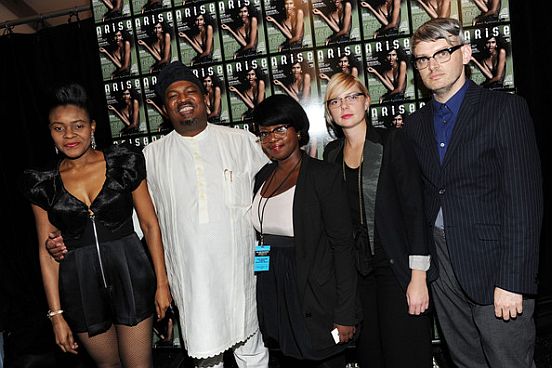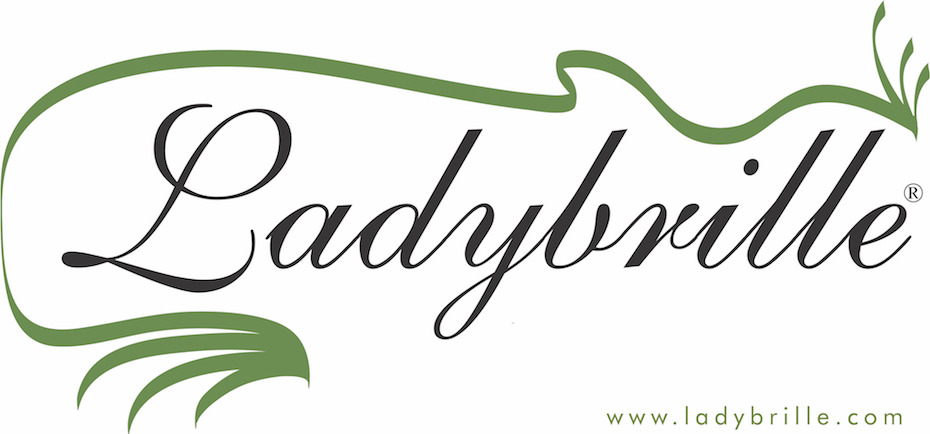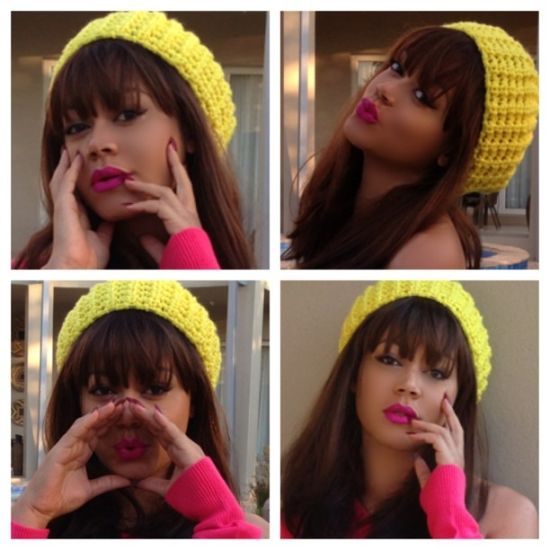 Saturday February 13th, 2010 was the the 3rd installment of the Arise Magazine African Collective fashion showing during New York Fashion Week. With the heightened buzz and rave reviews from mainstream and fashion press for the previous two collective showings, the African and American fashion elite gathered in The Tent, the largest space at the historic location. Despite the size of the space, the room was filled to capacity with fashionistas. Notable attendees such as Liya Kebede, Philip Bloch, Veronica Webb, June Ambrose, Memsor Kamarake, Bethann Hardison, Emil Wilbekin, and Luca Orlandi fashion designer and husband of supermodel Oluchi squeezed into the space for the show. The event space was decorated in all black while the runway entrance was designed with light colored square panels of varying sizes staggered along the front wall. As the crowd settled into their seats the lights dimmed to almost pitch black and a soundtrack resembling an oncoming African storm boomed out of the speakers. The spotlight was on the stage entrance as the Arise logo came up and the lights flashed, further communicating the storm theme.
Saturday February 13th, 2010 was the the 3rd installment of the Arise Magazine African Collective fashion showing during New York Fashion Week. With the heightened buzz and rave reviews from mainstream and fashion press for the previous two collective showings, the African and American fashion elite gathered in The Tent, the largest space at the historic location. Despite the size of the space, the room was filled to capacity with fashionistas. Notable attendees such as Liya Kebede, Philip Bloch, Veronica Webb, June Ambrose, Memsor Kamarake, Bethann Hardison, Emil Wilbekin, and Luca Orlandi fashion designer and husband of supermodel Oluchi squeezed into the space for the show. The event space was decorated in all black while the runway entrance was designed with light colored square panels of varying sizes staggered along the front wall. As the crowd settled into their seats the lights dimmed to almost pitch black and a soundtrack resembling an oncoming African storm boomed out of the speakers. The spotlight was on the stage entrance as the Arise logo came up and the lights flashed, further communicating the storm theme.
The first showing under the title of “First Light” was the collection from Black Coffee, a South African brand designed by fashion designers Danica Lepen and Jacques van der Watt, who also recently won the coveted The Mercedes-Benz Art Award in South Africa. For anyone who had attended either of the two previous Arise Magazine Collective shows, the designs and theme of the Black Coffee showing was a shock. The avant-garde designs combined with the thunderous, yet solemn lighting and music was certainly not something that one would associate with typical African fashion. While unexpected, the collection set the stage for the attendees to experience something new in African fashion. Much of the collection was in muted colors. The garments were a mix of free-flowing and intricately pinned and padded layers reminiscent of African masks and organisms. As the models paraded down the runway, you could almost hear a pin drop, were it not for the heavy dark beats. (See pictures of the Black Coffee collection here)
The next segment of the showing was dedicated to Tanzanian designer Anisa Mpungwe’s Loin Cloth and Ashes. Continuing the shows theme of an African Autumn, Ms. Mpungwe’s segment was titled “Noon”. Opening with a more upbeat yet mysterious atmospheric theme Loin Cloth and Ashes was again, not the colorful and flowy designs one would expect from an African designer. The clothing was a monochromatic parade of blacks and greasy with accents of blue patterns in the fabric and accessories. They cut was close to the body with strong geometric shapes accenting the hips and shoulders. With a projection of origami birds decorating the runway backdrop, the models of the evening – including Chanel Iman, Oluchi, and Sessilee Lopez, looked confident and powerful in the dresses and suits. (See Lion Cloth & Ashes Fall 2010 Pictures here)
Finally, Nigerian designer Deola Sagoe’s “Midnight” segment opened with a projection of a huge African moon rising to a steady dark African beat. Obviously the crowd favorite, Sagoe’s ‘Above the Fray’ Fall collection was inspired by East African Maasai warriors and 18th century European military uniforms. The showing was faster paced than the previous collections of the evening with a parade of models of all ethnicities wearing Sagoes designs of mostly black, blue and gold dresses. The collection was a close fitting mix of lace and beading with peek-through hints of colors. Again, the theme of the night was volume and geometry, with Sagoe’s designs focusing the trend on the shoulders. As the models finally exited the stage, Deola Sagoe was treated to a standing ovation. In all the Arise Magazine African Collective Part III show was a pleasant surprise. (See Deola Sagoe pictures here.)
Most attendees, I spoke to expected a mostly upbeat colorful event, but the show instead was about a pointed feminine strength. Far from leaving the audience wanting, the show challenged our expectations of what African fashion should be, with all three designers bringing their own unique African artistic perspective to create an inspiring event.
~by G. Kofi Annan, special to Ladybrille Magazine
~Photocredit: Getty Images
~
Founded in 2007, Ladybrille® Magazine is a California based pioneer digital publication demystifying the image of Africans in the west through contemporary African fashion and celebrating the brilliant woman in business and leadership, with an emphasis on the African woman in the diaspora. Our coverage includes stories on capital, access to markets, expertise, hiring and retention, sales, marketing, and promotions.



